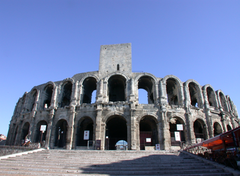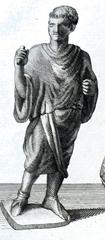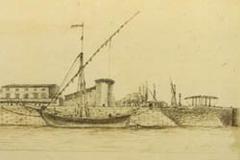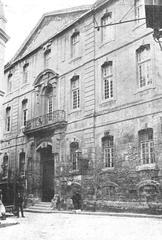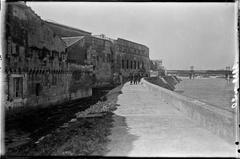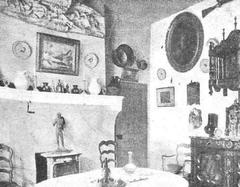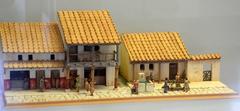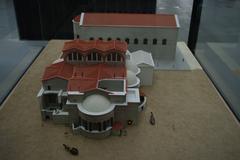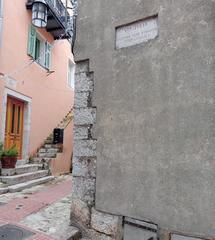Tour des Mourgues: Visiting Hours, Tickets, and Historical Sites in Arles
Date: 14/06/2025
Introduction
The Tour des Mourgues, a defining feature of Arles’ medieval cityscape, stands as a testament to centuries of urban evolution, military ingenuity, and religious heritage. Located on the northern edge of Arles’ historic center and once integral to the city’s defensive ramparts, this fortified tower offers visitors a unique lens into the layered history of Provence. Whether you are planning a visit or simply seeking to enrich your understanding of Arles’ architectural and cultural legacy, this comprehensive guide provides in-depth information on the Tour des Mourgues—covering its origins, architectural development, religious associations, visitor access, nearby attractions, and practical travel tips (The Creative Adventurer; arles-guide.com).
Table of Contents
- History and Origins
- Architectural Features and Evolution
- Religious and Cultural Significance
- Tour des Mourgues in Arles’ Urban Landscape
- Visitor Information: Hours, Tickets, and Access
- Facilities, Accessibility, and Amenities
- Guided Tours and Interpretation
- Nearby Attractions and Travel Tips
- Frequently Asked Questions (FAQ)
- Summary and Final Tips
- References
History and Origins
The history of the Tour des Mourgues is closely linked to the broader narrative of Arles, a city whose roots extend to the Ligurian settlers and flourished under Roman rule (The Creative Adventurer). Initially constructed as part of Arles’ Roman fortifications, the tower was later modified and expanded during the medieval period to meet evolving defensive needs. Its strategic position along the city’s ramparts underscores its role in safeguarding vital trade routes and protecting the population from external threats.
The name “Tour des Mourgues” (from the Provençal word for “nuns”) reflects its proximity to the influential Benedictine Abbey of Saint-Césaire, founded in the 6th century by Bishop Césaire. This monastic connection highlights the intertwining of religious and civic life in Arles’ past (arles-guide.com).
Architectural Features and Evolution
The Tour des Mourgues exemplifies the adaptive reuse of Roman foundations in medieval military architecture. Originally a large cylindrical structure, the tower was enveloped in the 14th century by an octagonal or polygonal casing, following trends that prioritized defensive strength and improved fields of vision. The base features a glacis—a sloped wall designed to deflect projectiles and impede attackers—demonstrating advanced military engineering (HMDB).
Visitors can observe the contrast between the robust Roman stonework in the lower sections and the polygonal medieval additions above. The use of local limestone ties the tower visually to nearby Romanesque structures, such as the Saint-Trophime Church and the amphitheater, reinforcing Arles’ cohesive architectural identity (arles-guide.com).
Religious and Cultural Significance
The Tour des Mourgues’ association with the Abbey of Saint-Césaire elevates its significance beyond that of a mere military outpost. The tower once formed part of the convent’s enclosure, serving both as a defensive structure and a symbol of the religious community’s autonomy. This duality is emblematic of Arles, where sacred and secular power often overlapped, especially during periods of political instability like the Wars of Religion (arles-guide.com).
The Provençal name “Mourgues” endures as a cultural marker, underscoring the city’s religious heritage and its role as a center of Christian life from late antiquity through the Middle Ages.
Tour des Mourgues in Arles’ Urban Landscape
Strategically positioned at the corner of Boulevard Emile Combes and near the Rhône River, the Tour des Mourgues not only marked the limits of the ancient city but also served as a visual and functional link between Arles’ historic core and the surrounding Camargue landscape. Its silhouette, alongside those of the Roman amphitheater and neighboring churches, forms an iconic part of Arles’ skyline (Evendo).
Today, the tower is a popular stop on self-guided and organized walking tours, integrating the medieval ramparts with modern city life. The pedestrian-friendly location makes it accessible for visitors exploring the city center on foot or by bicycle (The Crazy Tourist).
Visitor Information: Hours, Tickets, and Access
Location
- Address: 67 Boulevard Emile Combes, Arles, France
- Access: By foot, bicycle, car, or local bus (nearest stop: Boulevard Emile Combes) (Evendo)
Visiting Hours
- Exterior Access: Open year-round, 24/7, as the tower is an outdoor monument.
- Interior Access: The interior is generally closed to the public. Occasional guided tours or cultural events may include special access. Confirm in advance with the Arles Tourism Office.
Tickets and Admission
- Exterior viewing: Free, no ticket required.
- Combined Passes: The Arles Heritage Passes provide access to other monuments and museums in the city for a fee.
Facilities, Accessibility, and Amenities
- Accessibility: The surrounding area is paved and mostly flat, suitable for visitors with limited mobility, though some uneven surfaces and cobblestones remain.
- Restrooms: Public toilets are available nearby (see Arles City Guide PDF, p. 6-7).
- Parking: Limited street parking; recommended lots include Parking du Centre and the museum car park (Arles Antique Practical Information).
- Luggage Storage: Available at Taco and Co. near the SNCF train station.
- Nearby Refreshments: Numerous cafés, bakeries, and shops are within walking distance.
Guided Tours and Interpretation
- Self-Guided Visits: Informational panels (in French and sometimes English) detail the tower’s history and architectural evolution (HMDB).
- Guided Tours: Offered seasonally and during special events. English-language tours of Arles’ monuments are available Mondays at 4:30 PM (July–September) and Sundays at 3 PM (Arles Antique Practical Information).
- Special Events: The tower occasionally features in local festivals and heritage walks—check with the Arles Tourism Office for updates.
Nearby Attractions and Travel Tips
- Roman Amphitheater: A UNESCO-listed arena still in use for events.
- Saint-Trophime Church: Renowned for its Romanesque portal and cloister.
- Alyscamps Necropolis: A peaceful Roman burial ground with ancient sarcophagi.
- Departmental Museum of Ancient Arles: Exhibits Roman and early Christian artifacts.
Travel Tips:
- Visit early morning or late afternoon for the best light and quieter experience.
- Wear comfortable shoes for cobblestone streets.
- Bring water and sun protection, especially in summer.
- Consider a heritage pass for combined site access.
- Market days (Saturday mornings) can be busy—plan parking accordingly.
Frequently Asked Questions (FAQ)
Q: What are the Tour des Mourgues visiting hours?
A: The tower’s exterior is accessible at all times; interior visits are by special arrangement only.
Q: Is there an entrance fee?
A: No fee for exterior viewing. Passes or tickets may be required for guided tours or combined visits.
Q: Is the site accessible for people with disabilities?
A: The area is mostly accessible, though some cobblestones and uneven surfaces remain.
Q: Are guided tours available?
A: Yes—check with the Arles Tourism Office for current schedules.
Q: Where can I park?
A: Use public parking lots or the museum car park for convenience.
Q: Are pets allowed?
A: Policies may vary; confirm with the tourism office if you plan to bring pets.
Summary and Final Tips
The Tour des Mourgues remains a vital link to Arles’ historical identity—embodying its defensive past, religious associations, and ongoing community pride. With free and year-round exterior access, the tower is easy to include in any itinerary and is ideally situated near Arles’ other top attractions. To maximize your experience, check for special events, consider a heritage pass, and plan for nearby amenities. Responsible tourism and respect for site preservation help ensure that this remarkable monument endures for future generations (The Creative Adventurer; HMDB; unesco.org).
For the most current information on hours, tours, and accessibility, always refer to the Arles Tourism Office.
References
- The Creative Adventurer – The Ultimate Self-Guided Historical Walking Tour of Ancient Arles
- arles-guide.com
- HMDB – Tour des Mourgues Historical Marker
- Evendo – Tour des Mourgues Attraction
- Official Arles Tourism Website
- Arles Antique Practical Information
- UNESCO World Heritage List: Arles

